Common house gecko
| Common house gecko | |
|---|---|
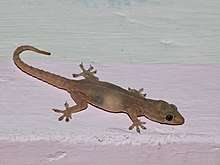 | |
| Scientific classification | |
| Kingdom: | Animalia |
| Phylum: | Chordata |
| Class: | Reptilia |
| Order: | Squamata |
| Family: | Gekkonidae |
| Genus: | Hemidactylus |
| Species: | H. frenatus |
| Binomial name | |
| Hemidactylus frenatus | |
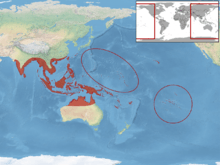 | |
The common house gecko (Hemidactylus frenatus) (not to be confused with the Mediterranean species Hemidactylus turcicus known as Mediterranean house gecko), is a reptile native of Southeast Asia. It is also known as the Pacific house gecko, the Asian house gecko, house lizard, or Moon Lizard.[3]
Habitat
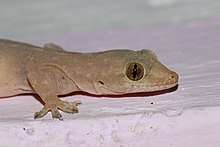

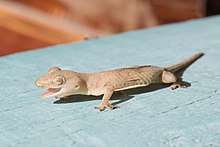
Most geckos are nocturnal, hiding during the day and foraging for insects at night. They can be seen climbing walls of houses and other buildings in search of insects attracted to porch lights, hence their name "house gecko". Spread around the world by ships, these geckos are now common in the Deep South of the United States, large parts of tropical and sub-tropical Australia, and many other countries in South and Central America, Africa, South Asia, and the Middle East. In winter time, in a lot of these climates, they are known for going into a state of brumation in order to withstand the cold. They grow to a length of between 75–150 mm (3–6 in), and live for about 5 years. These small geckos are non-venomous and not deadly to humans. Medium to large geckos may bite if distressed; however, their bite is gentle and will not pierce skin. A tropical gecko, Hemidactylus frenatus thrives in warm, humid areas where it can crawl around on rotting wood in search of the insects it eats. The animal is very adaptable and may prey on insects and spiders, displacing other reptiles.
Etymology
Like many geckos, this species can lose its tail when alarmed. Its call or chirp rather resembles the sound "gecko, gecko". However, this is an interpretation, and the sound may also be described as "tchak tchak tchak" (often sounded three times in sequence). In Asia/Southeast Asia, notably Indonesia, Thailand, Singapore, and Malaysia, geckos have local names onomatopoetically derived from the sounds they make: Hemidactylus frenatus is called "chee chak" or "chi chak" (pr- chee chuck), said quickly. Also commonly spelled as "cicak" in Malay dictionaries. In the Philippines they are called "butiki" in Tagalog, "tiki" in Visayan, "alutiit" in Ilocano, and in Thailand "jing-jok" (Thai: จิ้งจก[4]). In Myanmar, they are called "အိမ်မြှောင် - ain-mjong" ( "အိမ် - ain" means "house" and "မြှောင် - mjong" means "stick to"). In some parts of India and in Pakistan they are called "chhipkali" (Urdu:چھپکلی, Hindi: छिपकली), from chhipkana, to stick. In Nepal they are called "bhitti" (Nepali: भित्ती) or "mausuli" (Nepali: माउसुली). In other parts of India they are called "kirli" (Punjabi: ਕਿੜਲੀ), "jhiti piti" (Oriya: ଝିଟିପିଟି), "zethi" (Assamese: জেঠী), "thikthikiaa" (Maithili: ठिकठिकिया), "paal" (Marathi: पाल), "gawli" or "palli" (Malayalam: ഗവ്ളി (gawli), പല്ലി (palli), Tamil: பல்லி (palli)), Telugu: బల్లి (balli), Kannada: ಹಲ್ಲಿ (halli), "ali" (Sylheti: ꠀꠟꠤ). In West Bengal and Bangladesh they are called "tiktiki" (Bengali: টিকটিকি) as the sound is perceived as "tik tik tik". In Sri Lanka they are called "huna" in singular form (Sinhalese: හුනා). In Central America they are sometimes called "Limpia Casas" (Spanish: Housecleaners) because they reduce the amount of insects and other arthropods in their homes and also called 'qui-qui' because of the sound they make.
Distribution
This gecko is native to South and Southeast Asia, where it coexists with many other house geckos. It has been introduced and later established in many parts of the world as a result of trading movements. At the present, the Asian House geckos can be found in coastal areas of East Asia (including Japan), Australia, Pacific Islands, Indian Ocean Islands (including Mauritius, Madagascar and Maldives), North America, South America, Africa, Middle East and Caribbean Islands.
House geckos in captivity
House geckos can be kept as pets in a vivarium with a clean substrate, and typically require a heat source and a place to hide in order to regulate their body temperature, and a system of humidifiers and plants to provide them with moisture.
The species will cling to vertical or even inverted surfaces when at rest. In a terrarium they will mostly be at rest on the sides or on the top cover rather than placing themselves on plants, decorations or on the substrate, thus being rather inconspicuous.
House geckos are also used as a food source for some snakes.
Invasive species
In many countries, Hemidactylus frenatus is an introduced species that is considered a pest[5] and even a "serious threat species" to local wildlife.[6] While the impact of the Asian house gecko has not yet been closely studied, there is evidence that this "generalist predator"[7] can compete with native gecko species for resources and perhaps replace them, especially in urban areas.[6][8] Asian house geckos have transferred disease-carrying mites to native species.[9]
Superstition
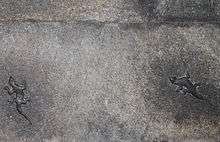
Geckos are considered poisonous in many parts of the world. In Southeast Asia, geckos are believed to be carriers of good omen.
In Yemen and other Arab countries, it is believed that skin disease result from geckos walking over the face of someone who is asleep.
An elaborate system of predicting good and bad omens based on the sounds made by geckos, their movement and the rare instances when geckos fall from roofs has evolved over centuries in India.[10][11] In some parts of India, the sound made by geckos is considered a bad omen; while in Bangladesh and Nepal, it is considered to be an endorsement of the truthfulness of a statement made just before, because the sound "tik tik tik" coincides with "thik thik thik", which in many Indian languages, means "right right right", i.e., a three-fold confirmation. The cry of a gecko from an east wall as one is about to embark on a journey is considered auspicious, but a cry from any other wall is supposed to be inauspicious. A gecko falling on someone's right shoulder is considered good omen, but a bad omen if it drops on the left shoulder. In Punjab, it is believed that contact with the urine of a gecko will cause leprosy.[12] In some places in India, it is believed that watching a lizard on the eve of Dhanteras is a good omen or a sign of prosperity.
Notes
- ↑ Ota, H. & Whitaker, A.H. 2010. Hemidactylus frenatus. The IUCN Red List of Threatened Species 2010: e.T176130A7184890. https://dx.doi.org/10.2305/IUCN.UK.2010-4.RLTS.T176130A7184890.en. Downloaded on 08 June 2018.
- ↑ "ITIS Standard Report Page: Hemidactylus frenatus". ITIS Report. ITIS-North America. Retrieved 2009-06-29.
- ↑ Drs. Olivia & Ava Conway
- ↑ Tiyapan, Kittisak Nui (20 April 2018). "Thai Grammar, Poetry and Dictionary, in a New Romanised System" (in Thai). Lulu.com. p. 102. ISBN 9789741718610 – via Google Books.
- ↑ "Photo guide to pest animals". Daff.qld.gov.au. 2012-11-07. Archived from the original on 2013-05-18. Retrieved 2013-12-14.
- 1 2 "Pest animal risk assessment : Asian house gecko" (PDF). Daff.qld.gov.au. Retrieved 2015-11-02.
- ↑ "Gecko invasion spreads". Gympie Times. 2012-01-13. Retrieved 2013-12-14.
- ↑ "Asian house gecko". Daff.qld.gov.au. 2012-10-09. Archived from the original on 2012-11-26. Retrieved 2015-11-02.
- ↑ Nicky Phillips (2013-02-09). "Geckos become the reptile rulers with successful invasion". Smh.com.au. Retrieved 2013-12-14.
- ↑ "ഗൗളിശാസ്ത്രം | Mashithantu | English Malayalam Dictionary മഷിത്തണ്ട് | മലയാളം < - > ഇംഗ്ലീഷ് നിഘണ്ടു". Dictionary.mashithantu.com. Retrieved 2013-12-14.
- ↑ "Hindu Omens". Oldandsold.com. Retrieved 2013-12-14.
- ↑ "The Folklore of Geckos : Ethnographic Date from South and West Asia". Nirc.nanzan-u.ac.jp. Retrieved 2014-02-02.
References
- Cook, Robert A. 1990 Range extension of the Darwin house gecko, Hemidactylus frenatus. Herpetofauna (Sydney) 20 (1): 23-27
- Darevsky I S; Kupriyanova L A; Roshchin V V 1984 A new all-female triploid species of gecko and karyological data on the bisexual Hemidactylus frenatus from Vietnam. Journal of Herpetology 18 (3) : 277-284
- Edgren, Richard A. 1950 Notes on the Neotropical population of Hemidactylus frenatus Schlegel Natural History Miscellanea (55): 1-3
- Edgren, R. A. 1956 Notes on the neotropical population of Hemidactylus frenatus Schlegel. Nat. Hist. Misc. 55: 1-3.
- Jerdon, T.C. 1853 Catalogue of the Reptiles inhabiting the Peninsula of India. Part 1. J. Asiat. Soc. Bengal xxii [1853]: 462-479
- McCoy, C. J.;Busack, Stephen D. 1970 The lizards Hemidactylus frenatus and Leiolopisma metallica on the Island of Hawaii Herpetologica 26 (3): 303
- Norman, Bradford R. 2003 A new geographical record for the introduced house gecko, Hemidactylus frenatus, at Cabo San Lucas, Baja California Sur, Mexico, with notes on other species observed. Bulletin of the Chicago Herpetological Society. 38(5):98-100 [erratum in 38(7):145]
- Ota H 1989 Hemidactylus okinawensis Okada 1936, junior synonym of H. frenatus in Duméril & Bibron 1836. J. Herpetol. 23 (4): 444-445
- Saenz, Daniel;Klawinski, Paul D. 1996 Geographic Distribution. Hemidactylus frenatus. Herpetological Review 27 (1): 32
External links
| The Wikibook Animal Care has a page on the topic of: House Gecko |


- House Gecko Info and Care
- Interaction of Asian House geckos and Wasps
- Asian House Gecko in Laguna de Apoyo Nature Reserve, Nicaragua
